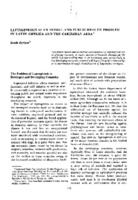Leptospirosis as an animal and public health problem in Latin America and the Caribbean area
| dc.contributor.author | Szyfres, B | es_ES |
| dc.date.accessioned | 2016 | |
| dc.date.available | 2016 | |
| dc.date.issued | 1976 | es_ES |
| dc.identifier.uri | https://iris.paho.org/handle/10665.2/27664 | |
| dc.description.abstract | As a major livestock disease, leptospirosis cuts significantly into the world's supply of animal protein through its consequences of abortion and calf mortality, retarded growth, and reduced milk production. Evidently, such losses have severe economic implications as well. The disease's impact has been somewhat diminished in the developed countries thanks to mechanization of rural activities, improved personal and environmental hygiene, and broad application of preventive measures, including the administration of bacterins, in domestic animals. Still, even in these circumstances it remains a serious problem. In the developing countries, in which large percentages of the population live in close contact with animals, the spread of infection is much greater. Moreover, the ecology of tropical and subtropical America--with its abundant rainfall, natural water courses, and high temperatures--is particularly favorable for the transmission of leptospires. In such conditions the human disease is a growing threat as well. The spread of leptospirosis, both in animals and man, is facilitated by the fact that inefection from many of the serotypes can exist without presenting serious clinical manifestations. Hence the importance of laboratory diagnosis. Systematic studies over time of serotype distribution, coupled with wide and improved surveillance, will be a key factor in bringing the disease under control. According to the limited seroepidemiologic data available, 3 to 18 per cent of the general human population, 2 to 32 per cent of those belonging to exposed occupational groups, and 10 to 50 per cent of patients with fever of unknown origin have leptospiral antibody. The most predominant serogroups are Icterohaemorrhagiae, Canicola, Pomona, Hebdomadis, and Bataviae. So far more than 50 serotypes, from 15 serogroups, have been isolated from man and animals in Latin America and the Caribbean area (Au) | en_US |
| dc.relation.ispartofseries | Bulletin of the Pan American Health Organization (PAHO);10(2),1976 | en_US |
| dc.subject | Developing Countries | es_ES |
| dc.subject | Leptospirosis | es_ES |
| dc.subject | Public Health | es_ES |
| dc.subject | Latin America | es_ES |
| dc.subject | West Indies | es_ES |
| dc.title | Leptospirosis as an animal and public health problem in Latin America and the Caribbean area | en_US |
| dc.type | Journal articles | en_US |
| dc.rights.holder | Pan American Health Organization | en_US |
Files in this item
This item appears in the following Collection(s)
-
Pan American Journal of Public Health
Revista Panamericana de Salud Pública




